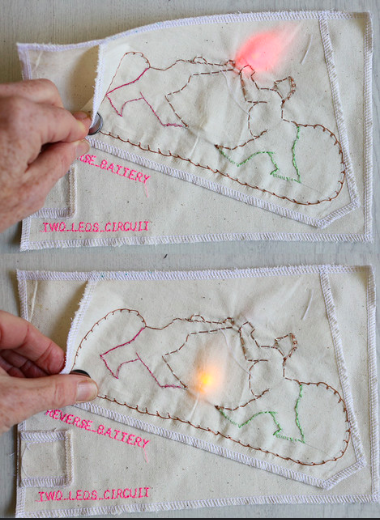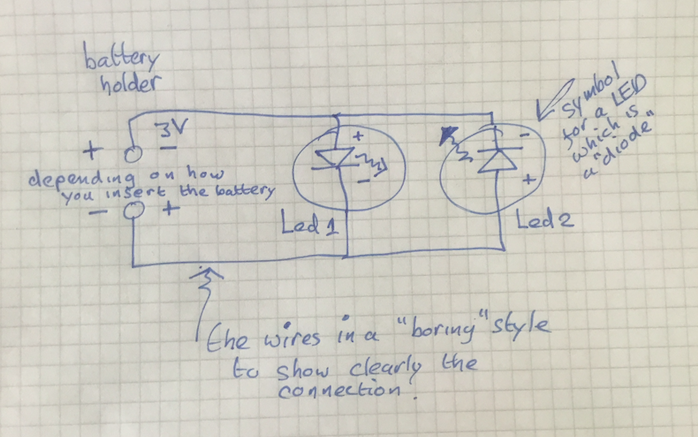Difference between revisions of "Mona-lisa"
| (4 intermediate revisions by one other user not shown) | |||
| Line 5: | Line 5: | ||
[[File:ml1.png]] | [[File:ml1.png]] | ||
| − | [[File:ml2.png]] | + | This is the basic circuit. |
| + | You have to know the components, what they do, why it works. | ||
| + | This will be explained in class. | ||
| + | |||
| + | {| | ||
| + | |[[File:ml2.png]] | ||
| + | |[[File:ml4.png]] | ||
| + | |} | ||
| + | |||
| + | |||
| + | This is the Mona Lisa I want to create. | ||
| + | It nearly matches the face of this beautiful 2D lady. | ||
| + | I have added Mona Lisa version as a comparison. | ||
| + | |||
[[File:ml3.png]] | [[File:ml3.png]] | ||
| + | Adding the wiring so that it "works". | ||
| + | |||
| + | In making this circuit work, you have to know some ways to connect LED's....parallel and series. | ||
| + | This will be explained in class. | ||
| + | |||
| + | In this Tinkercad project somebody played with wires and a breadboard: https://www.tinkercad.com/things/hIfVlq5VhOj-line-art | ||
| + | But this is not working at all! It shows great abstract art - well great... | ||
| + | |||
| + | Reality. | ||
| + | |||
| + | In Tinkercad you can make your Mona Lisa work - if it is connected right! | ||
| + | |||
| + | It will also give warnings for the LED's - if the get too much current. | ||
| + | |||
| + | This is the project on Tinkercad: https://www.tinkercad.com/things/fz7tjy2E9JQ-basic-circuit-drawing | ||
| + | |||
| + | What about "reality"? | ||
| + | |||
| + | Reality is ... messy. Even when you have the circuit right in Tinkercad, your project can fail because there is a bad connection, because the soldering wasn't done well, because internally a wire is broken.... | ||
| + | And many other reasons, battery is out of steam, some wires touching - short circuit. | ||
| + | |||
| + | That is way Tinkercad is great, but reality is the real. reality in that sense is creative itself. Creativity is destructive most of the time. Then you have to find out why your circuit is not working. This requires a boring checking of all ways the circuit might be faulty. We are in the middle of creativity and boring checking why something does not work! | ||
| + | |||
| + | [[File:ml5.png]] | ||
| + | |||
| + | Bigger image: https://www.flickr.com/photos/contrechoc/30195227067/in/album-72157664460566867/ | ||
| + | |||
| + | So this circuit is "real". When I show it to students, it might always not work. | ||
| + | |||
| + | It uses a clever trick to get two LED's working: I made the battery holder "reversible". That means I can insert the battery in two ways, and depending on this the polarity changes and a different LED lights up. I can easily make a drawing of this funny circuit by pencil, but how to do this in the more rigid Tinkercad? | ||
| + | |||
| + | [[File:ml6.png]] | ||
| + | |||
| + | What you learnt is: funny ways to make circuits, in the mean time, you have seen some basic components, hopefully you have played with Tinkercad. | ||
| + | |||
| + | You can apply this experience for: making cartoon circuits, but also later on for adding this kind to Arduino circuits. | ||
| + | |||
| + | [[Category:Electronics]][[Category:Wearables]] | ||
Latest revision as of 12:50, 18 November 2022
The Mona Lisa is a famous painting. People flock to this painting because....other people flock to this painting. People like this painting - because you have to. Is the depicted image of a lady really so great? We cannot even think about this any more, because there is no room to maneuver anymore.
This Mona Lisa is the start of a series where I try to think about "boring" circuitry again. Let's do something different with this circuitry.
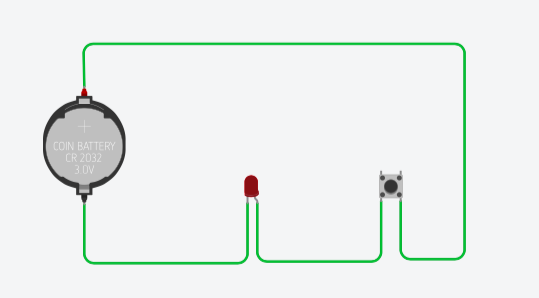 This is the basic circuit.
You have to know the components, what they do, why it works.
This will be explained in class.
This is the basic circuit.
You have to know the components, what they do, why it works.
This will be explained in class.
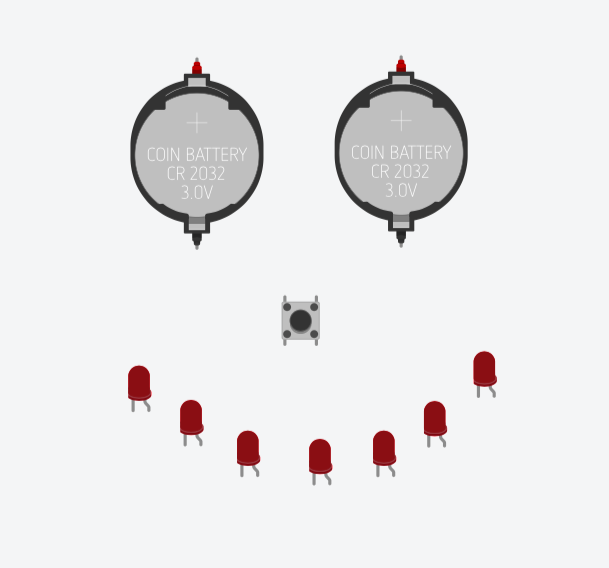
|

|
This is the Mona Lisa I want to create.
It nearly matches the face of this beautiful 2D lady.
I have added Mona Lisa version as a comparison.
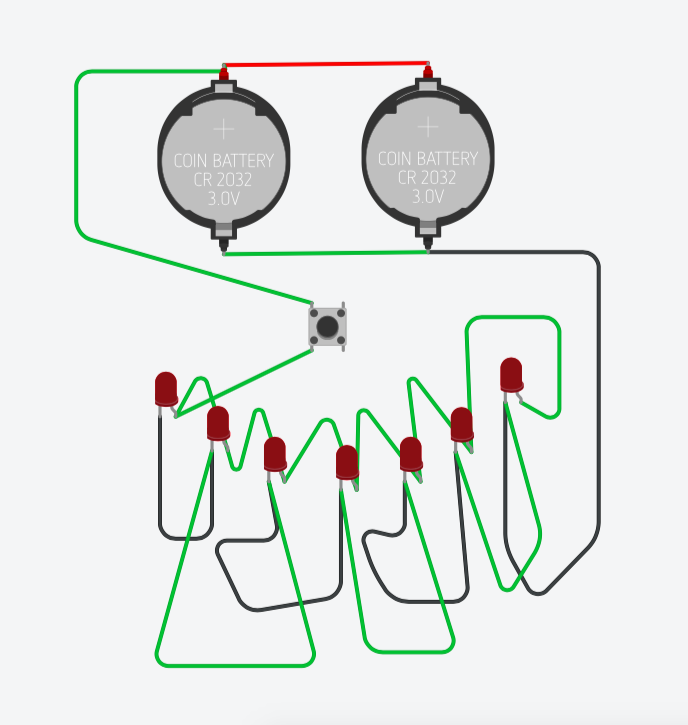 Adding the wiring so that it "works".
Adding the wiring so that it "works".
In making this circuit work, you have to know some ways to connect LED's....parallel and series. This will be explained in class.
In this Tinkercad project somebody played with wires and a breadboard: https://www.tinkercad.com/things/hIfVlq5VhOj-line-art But this is not working at all! It shows great abstract art - well great...
Reality.
In Tinkercad you can make your Mona Lisa work - if it is connected right!
It will also give warnings for the LED's - if the get too much current.
This is the project on Tinkercad: https://www.tinkercad.com/things/fz7tjy2E9JQ-basic-circuit-drawing
What about "reality"?
Reality is ... messy. Even when you have the circuit right in Tinkercad, your project can fail because there is a bad connection, because the soldering wasn't done well, because internally a wire is broken.... And many other reasons, battery is out of steam, some wires touching - short circuit.
That is way Tinkercad is great, but reality is the real. reality in that sense is creative itself. Creativity is destructive most of the time. Then you have to find out why your circuit is not working. This requires a boring checking of all ways the circuit might be faulty. We are in the middle of creativity and boring checking why something does not work!
Bigger image: https://www.flickr.com/photos/contrechoc/30195227067/in/album-72157664460566867/
So this circuit is "real". When I show it to students, it might always not work.
It uses a clever trick to get two LED's working: I made the battery holder "reversible". That means I can insert the battery in two ways, and depending on this the polarity changes and a different LED lights up. I can easily make a drawing of this funny circuit by pencil, but how to do this in the more rigid Tinkercad?
What you learnt is: funny ways to make circuits, in the mean time, you have seen some basic components, hopefully you have played with Tinkercad.
You can apply this experience for: making cartoon circuits, but also later on for adding this kind to Arduino circuits.
